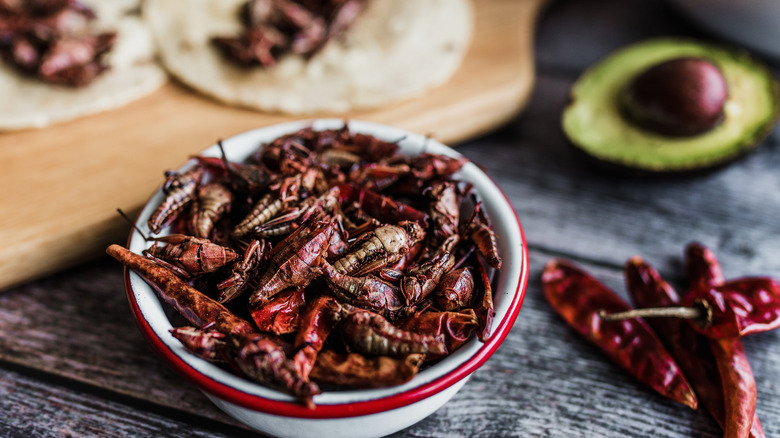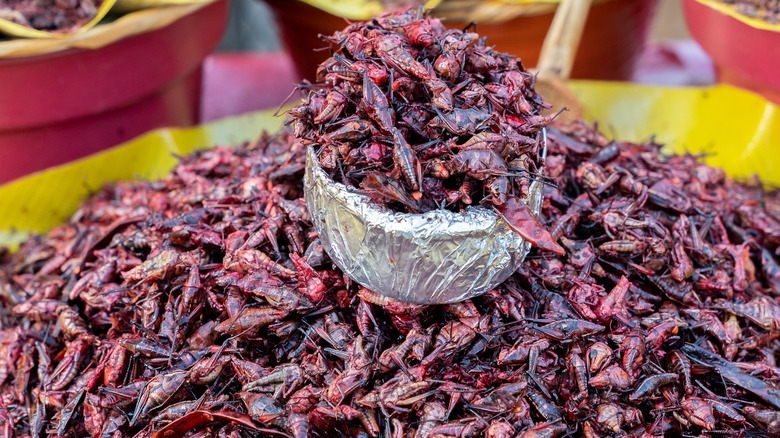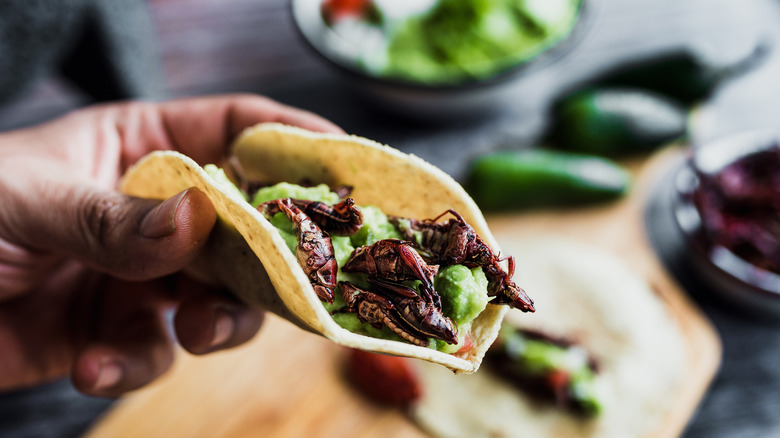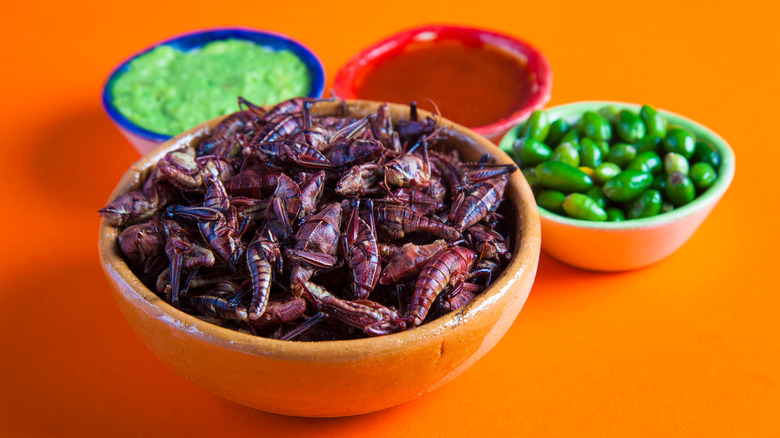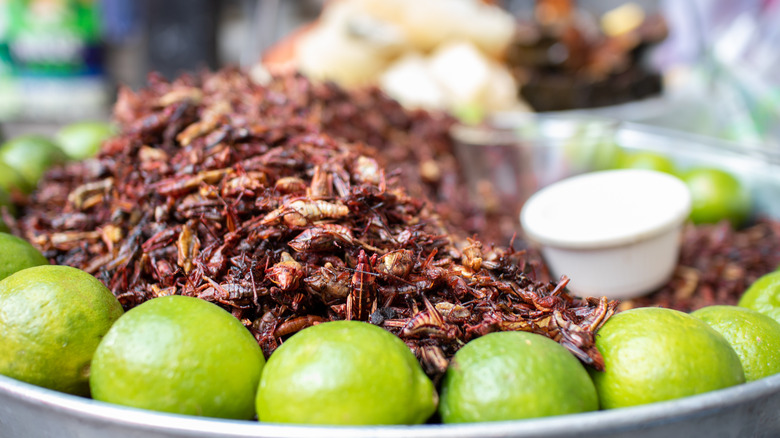If You're Curious About Eating Insects, Start With Grasshoppers
Although insects may not be on the plates of many Americans, they are consumed in abundance worldwide — a regular staple of nearly two billion people, notes the Library of Congress. Increasingly utilized in fine-dining kitchens and packaged as snacks, critters are breaking new frontiers of gastronomy, and for good reason. Noted for their environmental sustainability, protein density, and delicious taste, it's the exact kind of food innovation that eases modern challenges.
With more than two-thousand bugs to choose from, the first foray into eating insects may seem especially intimidating. With their pleasant crunchiness and mild taste, grasshoppers are an ideal entry point.
Widely eaten in Mexico, Central America, and Uganda, there's a good reason why these insects have become a staple of markets and everyday diets. Their ease of preparation allows for enjoyment in a variety of applications — from a snack at a baseball game to a salt rim for a cocktail. Let's get into what makes them so special.
History of chapulines
Grasshoppers have been a component of Meso-American cuisine for nearly 3,000 years. Consumed by Zapotec, Mixtec, Aztec, and Mayan civilizations, they're most strongly interlinked with what is now the region of Oaxaca. The nutritious insect is even included in the historical codex Tira de la Peregrinació, which relays the history of the Aztec people.
Their consumption has remained perennially popular, with reports of sales during the 16th century in the Tlatelolco market. Today, they continue to be an integral component of the cuisine of rural Oaxaca. In addition, the insects are hugely popular in Uganda. In the Central African nation, they're collected and then sold in barrels, either fresh, deep-fried, or boiled.
To increase availability, locals are developing methods to artificially breed them. This practice is poised to become ever more popular, with grasshopper harvest and sale now expanding to markets abroad . With increased availability, don't hesitate to try this delectable snack.
How are chapulines prepared?
Well-sourced, fresh chapulines will have a lightly herbal, aromatic flavor. Not very pungent on their own, most preparations incorporate aromatics for an extra zing. Added to dishes as a tangy, crunchy bite, the insects are enhanced with bright seasoning. Lime, garlic, salt, and chilies are especially popular go-to flavors.
To attain their trademark crunch, grasshoppers in Oaxaca are toasted on a comal, a traditional cast iron griddle. In Uganda, the insects are often boiled for preservation before also being toasted over charcoal. Both nations pull off the legs and wings of the chapulines for a more pleasant textural experience. While open-fire cooking does add an extra smoke component, using a normal frying pan in a typical kitchen setup also gets the job done.
Infusing flavor into the grasshoppers starts by sautéing garlic, chilies, and onions in olive oil until translucent. Sieve the veggies, and set them aside for another application. Next, cook the grasshoppers for around 10-15 minutes, until brown and crispy — heating thoroughly to kill off any unwanted bacteria, notes The Spruce Eats. Spritz with salt and lime, and serve as is or incorporate into dishes that need an extra crunch.
How are chapulines served?
Oftentimes, these tasty bites are simply consumed as a snack on their own alongside a glass of mezcal or a beer. Another boozy pairing is sal de chapulin – a salt rim that incorporates ground up grasshoppers. However, no need to intertwine it with a drink; the grasshopper is highly versatile — think of them like a crispy topping. These tangy bites provide a textural contrast to creamy avocado, making them an ideal topping for guacamole or a simple taco.
For a more Oaxacan rendition, top a ttalyuda — a large grilled flat-bread-like dish, with a prepared batch. Alternatively, consider adding some grasshoppers to an omelet or salad for a protein-enriching breakfast or lunch. Since they can be eaten whole or powdered, the sky's the limit — try out a tomatillo, Morita, and chapuline salsa.
Their unique attributes have recently caused a surge in popularity in both fine-dining and casual settings. Whether at a Seattle Mariner's game or a local taqueria, expect to find the snack in many forms. And with an addictive flavor and texture, it's easy to see why.
The extraordinary nutritional content of Chapulines
A grasshopper is 63% protein by weight, making them more protein dense than milk. In addition, they contain large quantities of magnesium, fiber, and vitamins. Such desirable nutritional qualities have made them increasingly valued as a food source, promoted by organizations like the U.N. Unlike other protein-dense food sources, Chapulines are packed with unsaturated fats — which are usually found in plants and esteemed for regulating blood cholesterol levels, notes WebMD.
New studies published by Frontiers in Nutrition have also shown the food's intriguing antioxidant properties. Even amongst other insects, grasshoppers exhibit a content of antioxidants greater than well-established heavy hitters like orange juice and olive oil. While not yet definite, researchers suggest this is due to unique proteins present in the insect.
And to top off their advantageous qualities, grasshoppers and other insects are also an ideal food source to combat climate change. Not only more saturated with magnesium, iron, and zinc per pound than beef, but they also require far fewer resources for cultivation.
Generating a much smaller volume of greenhouse gases than beef, their waste can be utilized as a fertilizer — so the insect's benefits only keep accumulating. All the more reason to dig into a batch.
